George MacDonald
Memories of Grandpa Mac's private life
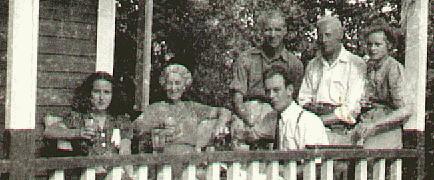

These pictures were taken about 1939 at Lac Guindon in the Laurentians, north of Montreal, where our family used to spend summmer vacations. In the group, seated, from left to right: George's daughter-in-law Elaine; George's wife, Millie; George's son Curtis (Elaine's husband). Standing, my father Ken Doherty (George's son-in-law); George; and Reta, George's daughter. And there's George in the right-hand picture, sunning himself on a rock.
Literature, classical music and golf some of his passions
We grandchildren all called George "Grandpa Mac."He once wrote me that he left school at the age of 13, and so never had a chance to learn about such things as philosophy and literature. But I remember him as a cultured and learned man. He must have educated himself quite vigourously throughout his life.
George knew a great deal about English literature, especially Shakespeare, and once mailed me a collection of Shakespeare plays. His gift to me when I graduated from high school in 1951 was the Oxford Companion to English Literature, and before that he presented me with a large volume of Bartlett's Familiar Quotations. About the same time, he gave me one of his most treasured books, an ancient classical dictionary printed in London in 1806. He had written his name inside the front cover and the date he acquired it -- 1896, when he was 15. I have made use of all three books often through the years, and still do.
Another of his passions, which I came to share, was classical music; mostly symphonies and concertos and grand opera. He had a sense of humour about opera, once writing to me: "You will find the plots awful trashy. As one cynical Frenchman wrote of operas; 'What is too silly to be said, we sing.'"
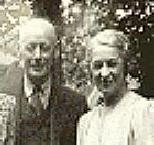 Perhaps some of his musical knowledge came from his wife, MILLIE. That's GEORGE AND MILLIE on the left in 1941. Millie was a member of the prominent Bishop family in the Eastern Townships of Quebec. She and George were married in 1907 just four years after George emigrated to Canada. They had three children: Reta, Margaret (my mother), and Curtis. In her time, Millie was an accomplished musician. My mother says she owned and played a grand piano, though I don't remember ever seeing it or hearing her play. But my cousin Clodagh (Reta's daughter) remembers "a big black grand piano, with a brilliant fuchsia and green Chinese shawl draped over it." We Doherty grandchildren called Millie "Nana;" other grandchildren called her "Grandma Mac."
Perhaps some of his musical knowledge came from his wife, MILLIE. That's GEORGE AND MILLIE on the left in 1941. Millie was a member of the prominent Bishop family in the Eastern Townships of Quebec. She and George were married in 1907 just four years after George emigrated to Canada. They had three children: Reta, Margaret (my mother), and Curtis. In her time, Millie was an accomplished musician. My mother says she owned and played a grand piano, though I don't remember ever seeing it or hearing her play. But my cousin Clodagh (Reta's daughter) remembers "a big black grand piano, with a brilliant fuchsia and green Chinese shawl draped over it." We Doherty grandchildren called Millie "Nana;" other grandchildren called her "Grandma Mac."
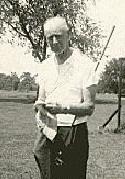 George also loved playing golf, and so did Millie. I don't know when George started playing, but when I was in my late teens he took me along to his golf course many times and taught me how to play, too. That was at the Wentworth golf course in west-end Montreal, later called Meadowbrook. There's George on the right, out on those links, sometime in the early 1950's. George's lessons were the only ones I ever had, and they have stood me in good stead. I have played the game off and on ever since, never getting very good at it, but always glad to be out on the links. On those rounds when nothing seemed to go right, I would hear again his voice in my ear: "Now Hughie, keep your left arm straight and your head down." Sometimes, that actually improved things! George was a stickler for the etiquette of golf as well as the basic skills. He once wrote a humourous two-page article about golf called "Hope Springs Eternal." I still have the original manuscript; the only piece of his writing I have, apart from his letters. To read it click here.
George also loved playing golf, and so did Millie. I don't know when George started playing, but when I was in my late teens he took me along to his golf course many times and taught me how to play, too. That was at the Wentworth golf course in west-end Montreal, later called Meadowbrook. There's George on the right, out on those links, sometime in the early 1950's. George's lessons were the only ones I ever had, and they have stood me in good stead. I have played the game off and on ever since, never getting very good at it, but always glad to be out on the links. On those rounds when nothing seemed to go right, I would hear again his voice in my ear: "Now Hughie, keep your left arm straight and your head down." Sometimes, that actually improved things! George was a stickler for the etiquette of golf as well as the basic skills. He once wrote a humourous two-page article about golf called "Hope Springs Eternal." I still have the original manuscript; the only piece of his writing I have, apart from his letters. To read it click here.
The Westmount apartment: a giant chandelier glittering with crystal
My earliest childhood memories of George and Millie are of their apartment in Westmount. It was at 4775 Sherbrooke Street West, just west of Green Ave. In those days, this was an area where the well-to-do lived. My grandparents lived there alone from at least 1935 to 1940. I remember it as an imposing brick and stone building, with a huge lobby from the ceiling of which hung a giant chandelier, glittering with crystal beads and pendants.I recall a bit about some family Christmas suppers there. There were many candles, turkey with all the trimmings, and my uncle Peter (husband of my grandparents' daughter Reta) would crack walnuts and drip a bit of red candle wax into the bottom of a half shell. Then he would stick a toothpick upright in the still-hot wax and make a small sail from a piece of paper napkin. He would impale this on the toothpick, and present me with a little sailboat. I would rush off to the bathroom to fill the sink with water and launch my new craft.
George, meanwhile, would retire to his easy chair after supper, and fall asleep for a while, oblivous to what was going on around him. I discovered later this a was a life-long habit of his; he often had to have what he called his "forty-winks" after supper.
Vacations in exotic places before a serious car accident
During the time George and Millie lived in Westmount, they told me and the rest of the family of their vacations in Trinidad and Tobago, in Florida and other southern states. They used to drive down south, and in 1939 were involved in a car crash that badly injured Millie. In a letter that year to the city income tax department in Montreal, George wrote: "The cause of the delay in paying the 1939 tax was an accident to my wife which necessitated an expensive operation and long hospitalization."In later years George and Millie would mention the accident to me occasionally, but never gave me any details that I can recall. Once, Millie rolled down her stocking on one leg, and showed me the healed white lines of several long, jagged scars, starting just above her knee. I remember being startled by what I saw because she didn't limp or show any sign that the injury bothered her.
In 1940, George reached the age of 60 and his employer, the Canadian Press, reacted to this milestone. Here's how George described it in a another letter to the Montreal income tax department:

Three years later his salary was cut another $5 a week, so his income had shrunk rather suddenly by more than a third.
Perhaps that's why, in 1940, George and Millie had moved to another apartment in a less affluent part of Montreal. It was at 5550 Cote St. Luc Rd. near the Snowdon area, still a pleasant and comfortable place to live.
 These were the years of the Second World War and while George was far too old to enlist, he became active on the civilian front. He joined
These were the years of the Second World War and while George was far too old to enlist, he became active on the civilian front. He joined  Montreal's Civilian Protection Committee and one of his duties was to act as an air raid warden.
Montreal's Civilian Protection Committee and one of his duties was to act as an air raid warden.
The threat of a German bombing raid on Montreal was taken very seriously in those days, and the city was organized in case one occurred. I remember practice blackouts at night when sirens wailed and all the lights in the city were turned off.
People in civilian cars had to pull over and turn off their lights. Private houses had to have blackout shades, or heavy drapes to keep light from shining out of windows. Air raid wardens like George patrolled the streets to make sure blackout regulations were being observed.
Members of the Civilian Protection Committee were also expected to be on the lookout at all times for spies and saboteurs.
Bicycling through farmland pasture for cookies and soft drinks
I used to visit George and Millie at their Cote St. Luc Rd. apartment quite often in the summertime. Our family lived in the suburb of Montreal West then, and I would ride my bicyle from there along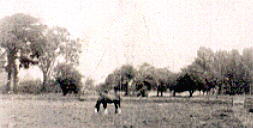 Cote St. Luc Rd. to the apartment -- it took me about an hour each each way. Between Montreal West and Montreal itself the road went through country farmland in the 1940's, with large pastures on either side. There's a picture on the right of a Cote St. Luc Rd. pasture I took on one of my bicycle trips. George wasn't often home when I visited,
he was working, but Millie nearly always was, and she treated me to large quantities of home-made cookies and soft drinks. All that ended in 1947 when our family moved to Sherbrooke, Que.
Cote St. Luc Rd. to the apartment -- it took me about an hour each each way. Between Montreal West and Montreal itself the road went through country farmland in the 1940's, with large pastures on either side. There's a picture on the right of a Cote St. Luc Rd. pasture I took on one of my bicycle trips. George wasn't often home when I visited,
he was working, but Millie nearly always was, and she treated me to large quantities of home-made cookies and soft drinks. All that ended in 1947 when our family moved to Sherbrooke, Que.
Millie died in 1950. George left the apartment, and lived for a while with his son Curtis and his family in St. Eustache-sur-le-lac, just outside Montreal.
A year or so later he moved back to the city, and lived in an apartment which had been the residence of his daughter Reta and her family. They had moved to Bermuda but kept the Montreal apartment for George to use. It was at 3375 Ridgewood Ave. in the Cote des Neiges area.
Living with George and his classical record collection
When I was 17, I spent two months in the summer of 1952 there with him. He had arranged a summer job for me at the Montreal Gazette, where he was now day editor. I became a proofreader, scanning long "proofs," or imprints of news columns for typographical errors. Because the Gazette was a morning newspaper I worked at night, from 6 p.m. to 2 a.m., at a desk with other proofreaders, located in the mechanical department. George, of course, worked a day shift so we didn't see too much of each other.
I spent a lot of my days at the apartment playing George's extensive collection of classical records, 78 rpm's at that time. When we did get a chance to talk, it was mostly about the Gazette and my prooreading work. George didn't talk much about his own job; he once said jokingly that all he did was correct proofs of the racing results.
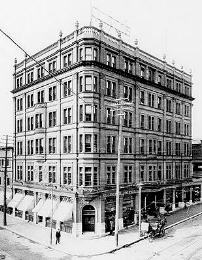
A year or so later George moved again, this time to a room in the Queen's Hotel (right) in downtown Montreal half a block away from the Gazette on St. Antoine St. He was able to walk to and from work in a few minutes. The Queen's was demolished in 1988, but then it was a popular, comfortable hotel. George paid $2.41 a day for his room.
He was still living there and working at the Gazette when he died suddenly of a heart attack January 6, 1955.
He had never told me much about his career, and his own experiences as a reporter and Canadian Press executive. But then, like most teenagers, I had never asked much. I wish now that I had.
George's home page |
The early years |
Letters to his grandson
Millie |
George and the R-100 airship |
George's father |
Final tribute
Comments? Click HERE to E-mail.
Page created January 2000. Last updated Apr. 8, 2006